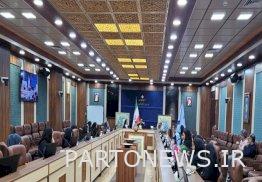Literature, history and aesthetics were examined in the art of flowers and birds

According to Aria Heritage report, citing the public relations of the Research Institute of Cultural Heritage and Tourism, Mehdi Mohammadi, a member of the faculty and director of the handicrafts department of Surah University, on May 13, 1402, said in the first panel of the meeting, which was held with the focus on literature and flowers, that if we want to talk about flowers and Whether we examine birds specifically or about other images, we must pay attention to the fact that the position of each bird changes in each text from each historical period in our literature. To this day it has been.
He added: In examining visual texts, we should pay attention to that phenomenon with the frameworks and texts of its time and study it more carefully and elegantly, in this way, both the results will become more attractive and by reading the literary texts of the past, which explicitly address that issue. We will have a better understanding of traditional arts.
In the continuation of this meeting, Mehdi Khanke, assistant professor of Islamic Azad University, in the introduction of his speech titled “Flower and Chicken”; Innovation in literature, development in painting to describe the manifestation of the position of innovation in a perfect human being; Khalifaullah discussed the topics of man and nature; manifestation in the allegory of the flower and the chicken, the flower and the chicken; He discussed the manifestation in poetry.
Referring to the manifestation of the role of flowers and birds in Iranian painting, he said: “The art of flowers and birds and, in line with that, painting is directly related to literature and poetry.”
Roya Omran, a researcher and designer of flowers and chickens, continued to examine the history of Syrian flowers in literature and lacquer painting and said: The rose is one of the most popular and popular flowers in the world, and the Mohammadi rose is the national flower of Iran.
He, with the allegory of the rose in different cultures, in explaining the relationship between literature and the rose, presented examples of the poems of poets such as Saadi, Enrati, Hafez, Baba Taher, Sohrab Sepehri, etc., and traced the root of the word flower.
In the second specialized panel of this meeting, Parviz Hashi, director of the Islamic Art Department of the Shahid Faculty of Arts, focused on reflection on the history and aesthetics of the art of flowers and birds, with a brief look at the painting of flowers and birds, posing the question of what is the scope of the term flowers and birds. It includes style, theme, decoration, application, and time frame, to describe the placement of flowers and chickens under the art of painting.
In explaining the relationship between flowers and birds with Iranian culture and literature, he explained the mythological aspect of flowers and birds, the aspects of flowers and birds, types of flowers, etc. He mentioned prominent artists of this field and discussed naturalistic, abstract, folk, poetic, decorative, etc.
In addition, Hassan Esmati, a lecturer at the university, expressed the necessity of studying painting from the perspective of literature and said: “The art of flowers and chickens has a symbolic expression, and to prove it, we should look for the evidence that literature provides us with this document.”
He continued to discuss the background of flowers and birds in literature and the works of some poets in the third to sixth centuries and related these poems with topics such as the place and importance of flowers in the poetry of poets, using the generic name of the bird instead of the specific name of the bird, analogies to Used for flowers and chickens, singing and conversation between nightingale and flower, description of nature in spring and similes used of different types of flowers in poems and works, divided and explained each topic.
In this meeting, archaeologist Haniyeh Sheikhi, director of the group and member of the faculty of Rasam Karaj University, also discussed a part of a research about the use of flower and bird motifs in Iranian arts (13th and 14th centuries AH in Iran) and stated that flower and bird painting is one of the elements He pointed to the tiles of mosques such as the Wakil Mosque of Shiraz, Agha Bozur Mosque, Seyed Isfahan Mosque, Chaharbagh School of Isfahan, the support of the viceroy of the king of Kermanshah, Golestan Palace, etc., and added: in these tiles, all kinds of birds Like peacocks, swans, etc., they are present next to flowers and trees.
Academic faculty member of Rasam Karaj University, pointing out that in addition to tile painting, flowers and birds have been used in mirror frames, pen boxes, book covers, jewelry boxes, eyeglass frames, and textiles. Margh mentioned Reza Abbasi, Mohammad Taher, Mohammad Zaman, Shafi Abbasi and…
At the end of the meeting, Reza Mirambin, a university lecturer and researcher, examined the phenomenon of flowers and chickens from the perspective of phenomenology in the special sense of Husserl (one of the important and influential German-Austrian philosophers of the 20th century and the founder of phenomenology).
Along with other speakers who talked about the creation and emergence of the art of flowers and birds, he spoke about the type of understanding of this art at the time of its creation and imagined the mentality of the artist at the time of the creation and independence of this art, what the world was like from his point of view. created the works.
end of message/

